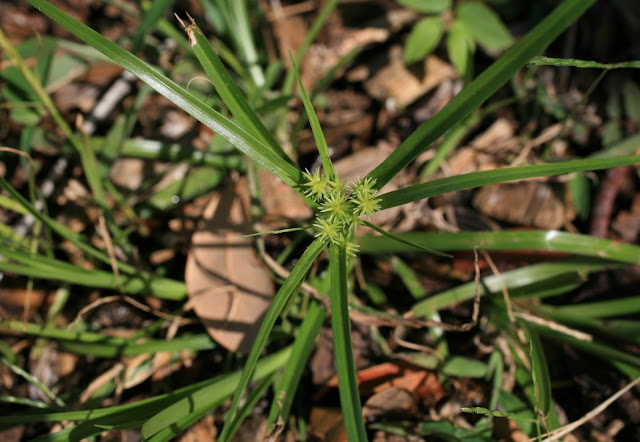 |
| A large, robust plant of Cyperus croceus growing in a patch of pineland heliotrope (Heliotropium polyphyllum) in my front yard. |
Cyperus croceus is a common native perennial that has been recorded from all but 12 counties in Florida. Since it occurs in a wide variety of habitats, including marshes, hammocks, sand scrub, sandhills, flatwoods, and disturbed areas, it likely occurs in every county in Florida. In urban areas, it can be found as a weed of neglected lawns, in fields, and along roadsides. It is also one of a group of natives that occurs spontaneously in my yard, especially in sunny areas where there is exposed soil devoid of mulch. Its common name is usually listed as "Baldwin's flatsedge," which is derived from a synonym for this species: Cyperus baldwinii. I prefer the more descriptive common name of "yellow flatsedge," derived from the species epithet, croceus, which means "saffron yellow." But bear in mind that the spikes are greenish when young, brownish when mature, and only somewhat yellowish for a brief period in between.
 |
| Younger, smaller plants have a graceful, rather delicate appearance. |
As one can well imagine, a plant that readily grows in both the wet soils of marshes and the dry sand of sandhills, in full sun to light shade, is effortlessly cultivated and it can often be established by simply scattering seeds in an open, sunny area. It is, as far as I know, never intentionally cultivated but I could see it being used as a 1–2 foot (0.3–0.6 meters) tall groundcover in a dry, sandy site where little else will grow well. It adapts very well to being mowed and I have seen lawns consisting mostly of Cyperus croceus in older urban neighborhoods. Wildlife value appears to be limited but it may serve as a larval food plant for Diploschizia impigritella, the yellow nutsedge moth. In wetland areas, its tiny, seedlike fruits are eaten by waterfowl and the foliage may be eaten by geese.
 |
| A close-up view of an early-stage inflorescence. |
Although it can be a bit weedy, yellow flatsedge grows in clumps and lacks underground rhizomes. Thus, it is easily weeded out by slicing the bottom of the plant from its roots. So long as no vegetative portion remains attached to the roots, it will not grow back. A few plants, here and there, add variety, texture, and interest to native plant gardens and, so long as bare soil is covered with mulch, leaf litter, or other plants, it rarely presents a serious weed problem. However, plants can form sizeable clumps, as seen in the first image above, and so it should be kept a safe distance from small or delicate wildflowers.
Images and text © 2013 Rufino Osorio

No comments:
Post a Comment